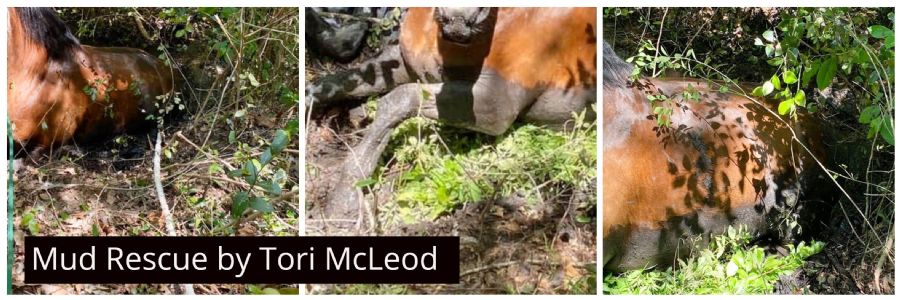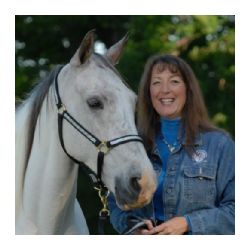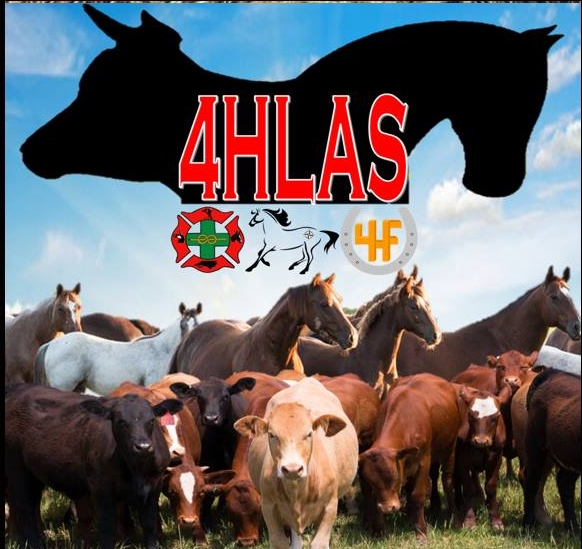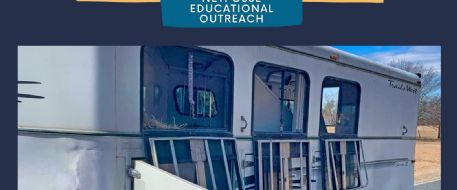
HORSE STUCK IN MUD - MAY 3, 2020
HOKE COUNTY, NC - Yesterday, while Justin and I were on the road in Georgia handling a horse transport, Justin received a call from a woman requesting our assistance with a horse that was stuck in the mud. The incident was at Calloway Preserve off Hwy 211 in Raeford, NC.
The caller was leasing the horse and they had been riding when she asked him to cross a narrow, shallow creek area that she had crossed many times before with other horses. He stepped into the creek bank and she said he sunk about 6-8 inches in the mud... this act may or may not startle some horses, but the horse she was riding panicked a bit and she said he sidestepped into a different area of the creek bed than where they were crossing and sunk his back legs deep in the mud in another area. She immediately notified the owner.
When we received the call, we could not respond but we contacted our team members and they responded. Three of our team leaders that were responding had “Go-Bags” that we provided them. In the Go-Bag is a helmet, two 30FT x 4IN webbing straps with loops on each end, an emergency rope halter, some lengths of ½-IN rescue rope that is rated for the weight of human or animal, and whatever else they chose to add. This basic equipment can resolve many of the incident scenarios if applied and used properly. Knowing that this was a mud rescue operation and mud can create a suction that needs to be released prior to extrication to lessen the chance of injury, we contacted my dad and put him on stand-by to hook up his truck to our large animal rescue equipment trailer if needed, and another team member to drive it to the scene if necessary.
We had asked the owner to send us some photos of the situation so we could know what our team members were responding to and forward to them so they could come up with Plan A, Plan B, etc while they were on the way. We instructed the owner not to stimulate the horse and just let him be until our team got there…maybe put some hay in front of him to eat but do not try to get him out of the mud because our team may need him to have the energy to physically help them help him and if he continues to struggle he would be exhausted by the time they arrived. We also asked her to contact a veterinarian to respond. The owner stated that where they were located was not accessible by truck and trailer, may be accessible by truck up to a point but would have to be by ATV or on foot from there to the incident site.
The photos we received showed the horse with its front end free and its back end in the mud. One pic showed with a halter and lead ropes and the others had no halter in place. Upon calling the owner back after receiving the photos I asked if the horse had a halter on and she said it did but she took it off because it was the wrong type (a grooming halter) and was just coming off anytime he moved or someone pulled on it. She stated that she sent someone to get a halter from the trailer and they retrieved the wrong one. We advised her to get a halter that fits that horse and the longest lead rope or lunge line that she had and if she could do so safely put it on the horse.
While our team was responding, we also contacted the location emergency communications center (911 dispatch) for the county and inquired as to who’s fire district the location was in and requested to notify them as a courtesy that the incident occurred and our team was responding and to put them on standby in case manpower was needed to maneuver the horse.
A local veterinarian was on the way to the scene. We were unsure whether this vet had any previous large animal rescue training or not but one of our team leaders was familiar with her from working alongside of her on veterinary cases with the clinic she works for so at least there was a personal familiarity there.
As our team leader was arriving at the Preserve, she was speaking to us on the phone while driving the dirt roads attempting to locate the owner, the incident scene, or anyone who could lead her there. Several minutes after we disconnected the call, we received a text message from her advising that the horse had self-rescued just prior to her arrival and all was good to cancel any additional response from our team. The owner reported the horse was doing well and she would not be crossing that creek bed again.
Upon speaking with the person who was with the horse and made the call, she stated that there were a couple of things that might have made this situation a little more complicated...the primary issue was the location. She stated that she rides there often and is familiar with the place and thought the directions she was giving our team member over the phone were clear and easy to follow to her location...however she said afterward she was retracing the directions herself with the point of view of someone who was not familiar with the location and had not ridden there before and realized how truly difficult the directions were to follow and the trouble that someone could have in locating the incident quickly. GPS apps and map-points might help with this in the future... if there is a way to send a Drop Point on a map where you are located to the responders via text they may be able to follow roads or paths between that point and their GPS location to find you faster instead of "turning right at the pine tree and go to the fire break and turn on the road to the left and then there will be a tree with a pink ribbon and pass that tree to the third dirt road on the right and we are about 1/2 a mile down that road approximately 150 feet into the woods on the right" (those were not the directions given by the caller but speaking from years of experience as a 911 Dispatcher that is a true example of some of the directions we receive from callers requesting assistance during emergencies). Those directions might be precise and clear to the caller who has walked, ridden, or driven that route or area before but to someone who has never been there or has been there but is not familiar with the area it can be difficult to follow and the pink ribbon might be laying on the ground instead of in the tree and the pine tree that he caller spoke of might be mistaken for a juniper tree by the responder...sooooo much room for miscommunication and error. The best option if there are people available is to send someone to the nearest public area or roadway to meet responders and guide them to the incident location... The second best option would be to provide GPS coordinates or a map-point and stay in contact with the responders.
We asked her why the tack was removed from the horse. She stated that she was concerned that it would become entangled or cause other issues as he struggled to free himself since there was an abundance of vines, small trees, sticks, and other natural debris around. Sometimes tack can work to your advantage when rescuing a horse...other times it can prove to be an obstacle and almost impossible to workaround. In this instance, the girth from the saddle, if left in place and disconnected from one side by our team member, could have been used to pull a piece of rope (tag line) or webbing strap under the horse's chest/belly by tying the rope/webbing to one side of the girth and using the other side of the girth, and saddle for a little more pulling surface, to position the rope/webbing instead of having to dig under the horse (which puts you in a dangerous position) when no other specialized equipment is available.
They removed the bridle. It is always important to have some sort of head restraint on the horse for directional control. We prefer not to use a bridle but if that is all you have available use it. After removing the bridle they did send someone to get a halter. It was mentioned that during the horse's efforts to self-rescue he managed to turn and point himself deeper into the vines and trees. Had he had on a halter with the longest lead rope available (distance = safety) his head could have been restrained from turning toward another direction allowing his body to follow...even if he is struggling. You never want to pull on an animal's head to get them out of a situation, especially not a horse's head. They need their head and neck to balance themselves and if they are trying to accomplish that, you are only making it more difficult to impossible for them to do when you are pulling against them...they are having to fight you to do what they need think they need to do to survive. You can use a halter and lead rope for restraint and directional control only...no lifting or pulling.
Another point to ponder is the caller said she was "leasing" the horse...not the "owner" So would the veterinarian who arrived been able to render care or euthanize (if needed) the horse without the owner's permission or proof that the leasee was authorized to make those decisions (like a copy of the lease agreement or limited power of attorney for animal healthcare). What if the horse wasn't leased with a contract and was just being borrowed by a friend to ride and the owner could not be contacted? Again, how would the vet proceed with treatment or euthanasia? Who would be responsible for the expenses and what monetary limit is set for that horse? Luckily in this case the owner was available by phone and was local and not out of state or country. This goes back to posts that I have previously made in this group concerning "Know your Number" and "In Case of Emergency" information.
A HUGE SHOUT OUT TO OUR AWESOME TEAM MEMBERS WHO WE KNOW WE CAN COUNT ON TO HANDLE EMERGENCY CALLS WHEN WE ARE UNAVAILABLE! Responding to the incident location were Kelli Kwapnioski, Tim Ryan, Susan B. McCrimmon, and Ashley Stuart Deemer. Willing to respond and put on stand-by were Lisa Kivett Dvm, Cowboycolt Baxter, Chris Christopher Mcleod, and Don Miller. THANK YOU ALL, WE COULD NOT DO IT ALL WITHOUT YOU!
We also would like to thank the leasee of the horse for contacting us to assist and also for allowing us to share this incident and photos with others for educational purposes. The photos have been cropped to hide any identifiable features of the horse and names have been withheld for privacy reasons.
Stolen Horse International provides news and other resources for free on this website. As a charitable organization we survive on the kindness of people like you. Please consider donating to help fund the organization or purchasing a NetPosse ID for your horse, dog or cat to help protect your beloved animals!
Debi Metcalfe

Debi Metcalfe
Founder | debi@netposse.com





Comments